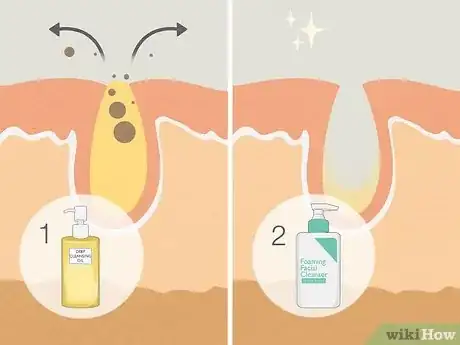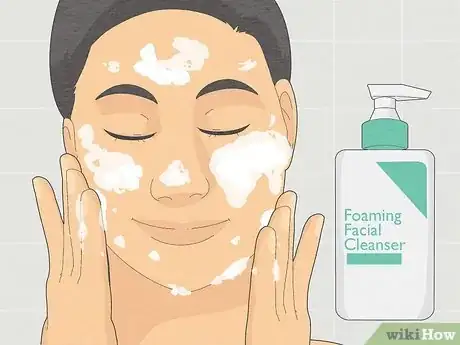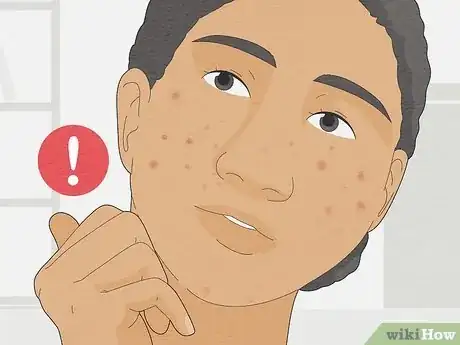This article was co-authored by Lydia Shedlofsky, DO and by wikiHow staff writer, Dev Murphy. Dr. Lydia Shedlofsky is a Resident Dermatologist who joined Affiliated Dermatology in July of 2019 after completing a traditional rotating internship at Larkin Community Hospital in Miami, Florida. She earned a Bachelor of Science in Biology at Guilford College in Greensboro, North Carolina. After graduation, she moved to Beira, Mozambique, and worked as a research assistant and intern at a free clinic. She completed a Post-Baccalaureate program and subsequently earned a Master's Degree in Medical Education and a Doctorate of Osteopathic Medicine (DO) from the Lake Erie College of Osteopathic Medicine.
There are 7 references cited in this article, which can be found at the bottom of the page.
This article has been viewed 2,045 times.
Since the double cleanse trend took the world by storm, it’s garnered millions of fans who swear by this squeaky-clean skincare ritual. Double cleansing is exactly what it sounds like—cleaning your face twice. But how do you do it? Stick around, and we’ll give you the skinny on why this skincare ritual might be for you, as well as the best way to double cleanse for your skin type.
Steps
How to Double Cleanse
-
1Apply a cleansing oil or balm to your face. Gently rub the product into your skin to break down any makeup, sunscreen, sebum, or grime you’ve picked up throughout the day.[3]
- Massage your face in upward circular motions, focusing on pore-concentrated spots, such as your nose and T-zone.
- You may find it helpful to apply your oil-based cleanser using circular cotton pads, especially if you are wearing eye makeup.
- If you have sensitive skin or rosacea, avoid using an abrasive washcloth or sponge, as these may irritate your skin.[4]
- Don’t break the bank on expensive products: often, less expensive products are just as effective.[5]
-
2Rinse your face with lukewarm water. Rinse as many times as needed to ensure all of the cleanser is gone.[6]
-
3Apply a water-based cleanser to your face. Gently rub the cleanser into your face for about 30 seconds.[7]
- For best results, use a low-pH cleanser. Low-pH cleansers will help your skin maintain its pH balance, whereas high-pH cleansers can strip away your skin’s natural lipids, resulting in irritation and dryness.[8]
- If you have oily skin, try a water-based foaming cleanser with active ingredients like salicylic acid, glycolic acid, or benzoyl peroxide. [9]
- You can use a cleansing foam.
- Use lukewarm water and a clean cloth to wet your skin.[10]
- Apply the product using a gentle circular motion. Wash off, then pat skin dry.[11]
- If you have dry skin, try a gentle, unscented cream cleanser, as this will dry out your skin less than a foaming cleanser.[12]
- If you have combination skin, try a foaming cleanser.[13]
-
4Rinse your face again. Continue to rinse until all cleanser is gone.[14] And that’s it! You’ve double cleansed your face, and now your skin is fresh and rejuvenated.
References
- ↑ https://www.aad.org/public/everyday-care/skin-care-basics/care/skin-care-budget
- ↑ https://health.clevelandclinic.org/double-cleansing-explained/
- ↑ https://health.clevelandclinic.org/double-cleansing-explained/
- ↑ https://www.rosacea.org/patients/skin-care/facial-cleansing-for-rosacea
- ↑ https://www.aad.org/public/everyday-care/skin-care-basics/care/skin-care-budget
- ↑ https://health.clevelandclinic.org/double-cleansing-explained/
- ↑ https://health.clevelandclinic.org/double-cleansing-explained/
- ↑ https://www.ncbi.nlm.nih.gov/pmc/articles/PMC4171909/
- ↑ https://health.clevelandclinic.org/double-cleansing-explained/
- ↑ https://www.cerave.com/skincare/cleansers/foaming-facial-cleanser
- ↑ https://www.cerave.com/skincare/cleansers/foaming-facial-cleanser
- ↑ https://health.clevelandclinic.org/double-cleansing-explained/
- ↑ https://health.clevelandclinic.org/double-cleansing-explained/
- ↑ https://health.clevelandclinic.org/double-cleansing-explained/
- ↑ https://health.clevelandclinic.org/double-cleansing-explained/
- ↑ https://health.clevelandclinic.org/double-cleansing-explained/
- ↑ https://health.clevelandclinic.org/what-products-do-i-actually-need-for-a-simple-everyday-skin-care-routine/
- ↑ https://www.mayoclinic.org/healthy-lifestyle/adult-health/in-depth/skin-care/art-20048237
- ↑ https://health.clevelandclinic.org/double-cleansing-explained/
- ↑ https://www.aad.org/public/everyday-care/skin-care-basics/care/skin-care-budget


































































